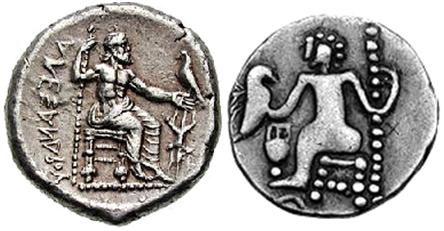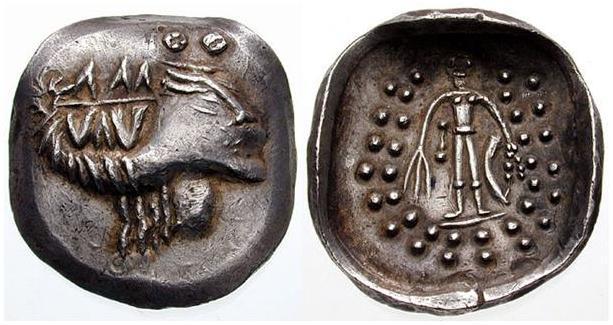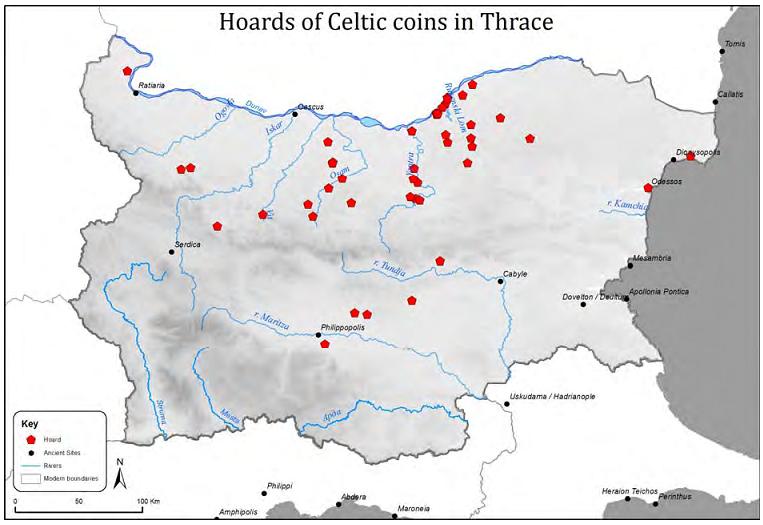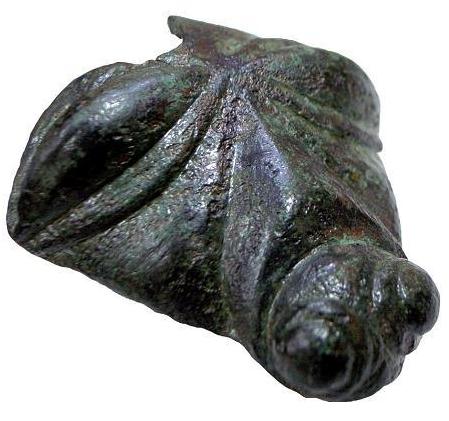Tag: Celtic coinage
METAMORPHOSIS IN GOLD – On Posthumous and Celto-Scythian Staters of the Lysimachus type in Crimea and the Pontic Region
“Nature is not only all that is visible to the eye, it also includes the inner pictures of the soul ”
(Edvard Munch)
With the defeat of Antigonus Monopthalmus and Demetrius Poliorcetes at Ipsus, vast territories were divided among the three victors…
Full Article:
.
BIRTH OF THE ICON – The Evolution of Celtic Abstract / Iconic Art
UD: March 2019
“A dreamer is one who can only find his way by moonlight, and his punishment is that he sees the dawn before the rest of the world”.
(Oscar Wilde)
The process of metamorphosis in Celtic art in Thrace during the 3rd – 1st c. BC may best be observed in ‘barbarian imitations’ of the Macedonian Alexander type tetradrachms, which most clearly allow us to follow the chronological framework in which this occurred. On the original Macedonian prototype(s) (fig. 1/2) the images are idealized but constructively/anatomically precise, which reflects the glorification of physical beauty and strength in its idealized form – an approach typical of classical art…
Full Article:
THE COTYS CONTRADICTION – Barbarian ΚΟΤΥΟC XAPAKTHP Coinage from Thrace
One of the greatest contradictions in ancient numismatics is the case of “barbarous” tetradrachms of the Thasos type produced in Thrace in the late 1st c. BC – previously attributed variously to the Roman puppet kings Cotys IV, VI and, most recently, to Cotys III (von Sallet 1876:242-24, Добруски 1897:629, Youroukova 1976:43-45; Юрукова 1992:177-178, de Callataÿ 2012:307–322; Paunov 2013, with relevant lit.).
In fact, the numismatic/archaeological context and execution of these coins, which bear the legend – ΚΟΤΥΟC XAPAKTHP, meaning the ‘die, stamp’ of Cotys (see Paunov, op cit.), raises a number of fundamental questions about their attribution to the Roman puppet kings in Thrace…
FULL ARTICLE:
.
2 Celtic Hoards from Rousse (n.e. Bulgaria)
After more than half a century of complete academic silence, the past few years have witnessed the miraculous (re)discovery of numerous hoards of Celtic coins from the Republic of Bulgaria. This phenomenon is particularly remarkable in the Rousse area, which has hitherto yielded the highest concentration of such numismatic material, leading Bulgarian experts to conclude that, “The line from Rousse to Veliko Tarnovo, mostly along the Jantra and Russenski Lom rivers, is the central axis of this type of Celtic coinage, respectively the Celtic tribal state/organization that produced it” (Paunov 2013)….
FULL ARTICLE:
https://www.academia.edu/5775102/Celtic_Hoards_from_Rousse_n.e._Bulgaria_
THE CURRENCY OF PLUNDER – On the Celtic Economic system in Thrace (2/1 c. BC)
Updated: July 2019
Ancient coins, and particularly hoards of such coins, are probably the most valuable indication of the geo-political situation in a region during a given historical period. A perfect example of this are a large number of hoards from Bulgaria dating to the 2nd / 1st c. BC, which contain a mixture of Celtic coins and Roman / Hellenistic issues. Particularly interesting are such hoards dating to the period of the Scordisci Wars (second half of 2nd c. BC / 1st c. BC) found at various sites across Bulgaria, which reflect the historically recorded events of the period.
An interesting example of this are the exceptionally large amounts of coins of the Roman Quaestor Aesillas found in hoards together with Celtic issues. Such hoards from Bulgaria include those from Chirpan, Nova Zagora, Haskovo, Levka (Haskovo region), Stroyno (Jambol region), Belitsa (Blagoevgrad reg.), etc. Aesillas was Roman quaestor in Macedonia from circa 90 – 75 BC, the period of the most frequent and devastating raids on the Roman province by the local Celtic and Thracian tribes.
Other such hoards of mixed Celtic and Roman issues dating from the same period (the first third of the 1st c. BC) include those from Topolovo (Plovdiv reg.), Kolyo Marinovo and Bratya Daskalovi (both in the Chirpan area of Stara Zagora region), Dolno Botevo (Haskovo region), and the Boljarino hoard also from the Plovdiv region (Prokopov 1995). It appears that the presence of such a high number of Roman issues from this period, found together with Celtic coins in Thrace, is a result of the aforementioned attacks on Roman territory in the southern Balkans and Greece, particularly those during the first third of the 1st c. BC.
Roman First Macedonian Region and Aesillas issues from the numismatic collection of the Kyustendil Regional Museum, Western Bulgaria
Hoards including coins of the Roman quaestor Aesillas have been found in the villages of Zhabokrut and Krumovo (Kyustendil region, Western Bulgaria), and near the village of Chepino, Pernik region (IGCH 646). Tetradrachm hoards of the First Macedonian Region have been found in the village of Skrino, Kyustendil region, in the village of Kralev Dol, Pernik region (IGCH 894), in the village of Studena, Pernik region and from the village of Turokovtsi, Trun area, Pernik region.
(After Filipova S., Ilya Prokopov I., Paunov E. The Numismatic Collection of the Regional Historical Museum at Kyustendil (Ancient Ulpia Pautalia) Part 1: Greek, Thracian, Macedonian, Roman Republican and Roman Provincial Coins. ( CCCHBulg ) Volume II. Sofia 2009)
Original Aesillas AR Tetradrachm (90 – 75 BC) and Celtic Thasos Tetradrachms discovered during the recent excavations at Bratya Daskalovi, Chirpan region, Bulgaria.
(after Prokopov I., Paunov E., Filipova S. Coins and Coin Hoards from the excavation of two burial mounds near the village of Bratya Daskalovi, Stara Zagora Region. In: Тонкова М. (ed.) Thraco-Roman dynastic centre in the Chirpan heights area. Sofia 2011)
Philip III (or Alexander III) original (?), Celtic ‘Philip III type” drachmas, and a Roman Republican Dinar (C. Naevius Balbus, minted in Rome in 79 BC), found together in a hoard at Bratya Daskalovi, Chirpan region
(after Prokopov et al 2011)
DAMNATIO MEMORIAE
The area of modern southwestern Bulgaria in particular has recently provided us with especially valuable information pertaining to the period of the Scordisci Wars (2nd half of 2nd / 1st c. BC). Hoards of silver coins dating to this period from the area of the western Rhodope mountains and the Upper Mesta river valley typically contain a mixture of Celtic and Roman/Hellenistic issues, i.e. – tetradrachms of the Celtic ‘Thasos type’ together with tetradrachms of the Athens ‘New Style’, First Macedonian Region, and the aforementioned Roman Quaestor Aesilla, as well as large numbers of Roman Republican dinars. Examples of such hoards have been recorded from the Belitza, Blagoevgrad, Gotsche Delchev, Kustendil, and Razlog areas.
Particularly noteworthy is the fact that many of the Celtic ‘Thasos type’ silver tetradrachms from Thrace are struck over Hellenistic/Roman issues, especially Athens New Style tetradrachms, as well as those of the Roman Quaestor Aesillas.
Celtic ‘Thasos type’ Tetradrachma minted over Athens ‘New Style’ original. Second decade of the 1st c. BC. (Popina hoard (#439). Silestra region, northeastern Bulgaria)
(After De Callatay, Prokopov 1994 (De Callatay F., Prokopov I. An Overstrike of a Hellenistic Tetradrachm in the Popina Hoard (ICGH 930). In: Numismatika Hronika. Hellenistic Numismatic Society. # 13. Athens 1994. P. 37-44)
Celtic ‘Thasos type’ tetradrachma minted over that of the Roman Quaestor Aesillas (early 1st c. BC)
On Herakles’ left knee the Q (short for Quaestor – similar to English P) can be seen. There are also faint traces of Alexander’s hair locks at the metal disturbance in Dionysos’ cheek from the Roman original.
A similar phenomenon is to be observed with ‘some thousands’ of bronze Celtic coins from the same period, also from the Rhodope/Upper Mesta area, most of which are minted over the coinage of Macedonian rulers and cities. Example of these ‘Strymon/Trident’ coins come from hoards discovered around the towns of Gotsche Delchev, Bansko, Eleschnitza, Razlog, Belitza, Jakoruka, and Ognyanovo.
Most fascinating about these coins is that in most cases they were not produced from blanks, but overstruck on Macedonian bronze issues (late royal or autonomous/Roman). The overstrikes are clearly visible and it is not hard to identify the host coin. Apparently, no attention was paid to the size, weight, denomination of the original host, or an attempt to adjust the dies of overstrikes. Host civic coins of Thessalonica, Amphipolis, and Pella, or Macedonian ‘autonomous’ issues, most dated to the period ca. 187 – ca. 50 BC, were used for the majority of these imitations (Paunov E. (2012).
Besides thousands of stray finds and smaller hoards, 7 larger hoards of such coins have been recorded in the Western Rhodope mountains and Struma Valley of today’s south-western Bulgaria. A particularly interesting example is that of the Bogolin 1989 hoard, which gives us a valuable insight into the phenomenon which was the Celtic economy in this area during the period in question. The Bogolin hoard initially consisted of circa 400 bronze coins, of which 100+ have subsequently been stolen. At the moment, 285 coins from this hoard are reportedly kept in the Blagoevgrad museum (Prokopov 1991, 1997; Paunov 2012; Paunov, Filipova, Prokopov 2013).
Celtic AE Strymon/Trident from the Bogolin hoard (Blagoevgrad Museum)
(after Paunov et al 2013)
In the case of the Bogolin hoard, according to analysis all 285 coins are overstruck on Macedonian coins (either Macedonian royal coinage or that of the Roman Macedonian province), i.e. all these Celtic issues were struck on coins plundered during the ‘barbarian’ raids, once more emphasizing the extent of the attacks on Roman territory during this period. Archaeological evidence thus indicates a unique phenomenon in European history – the Celtic tribes in the territory of today’s Bulgaria created a complex economy and monetary system based almost entirely on treasure which they looted during raids on Roman territory.
The historical context in which these coins were produced – during a bitter struggle between the ‘barbarians’ and the Roman empire, should also be borne in mind. From a psychological perspective the fact that the Celtic population in Thrace took the trouble to mint over the Roman/Hellenistic coins is a clear political statement – a rejection of the images portrayed on the originals, and by extension the ‘classical’ culture which produced them.
DEUS EX MACHINA – Celtic Hoards from Thrace
Major progress in archaeological and numismatic science in southeastern Europe has come with the recent completion of the work – From Koine To Romanitas – by Dr. Evgeni Paunov of Cardiff University (Paunov E. (2013)From Koine To Romanitas: The Numismatic Evidence For Roman Expansion And Settlement In Bulgaria In Antiquity (Moesia and Thrace, ca. 146 BC – AD 98/117) Phd. Thesis. School of History, Archaeology and Religion. Cardiff University. November 2013). In this comprehensive study the Bulgarian archaeologist/numismatist presents for the first time an objective overview of all the available archaeological and numismatic material from Thrace relating to the immediate pre-Roman and Roman periods – evidence which fundamentally alters our understanding of the history of s.e. Europe during this period.
From the perspective of the Celtic presence in Thrace, a number of conclusions in Dr. Paunov’s work are worthy of consideration..
Full Article:
https://www.academia.edu/3488614/Celtic_Coin_Hoards_from_Thrace
.
THE ART OF REJECTION – Balkan Celtic Art (Pdf.)

NUMISMATIC ART
Pdf. Version:
Book on the Numismatic Art of the Coriosolites tribe by J. Hooker:
PLASTIC METAMORPHOSIS ART:
ZOOMORPHIC/ANTHROPOMORPHIC ART:
Zoomorphic:
Anthropomorphic:
The Danube Torc:
Pdf:
TRISKELE/GOLDEN RATIO:
Pdf.:
Mac Congail
ERASING HISTORY – The Systematic Theft and Destruction of Celtic Material in Bulgaria
UD: March 2019
A number of factors should be borne in mind when dealing with the coin collections from Bulgarian museums. Since the early 1990’s attempts have been made by a number of Bulgarian and international experts to get access to information on the coin collections in the various museums around Bulgaria, and publish a comprehensive account of the information contained within. This fine work, which has resulted in catalogues of the collections from a handful of museums being published (the CCCHBulg series) has met with varying success. The philosophy of the authors of the CCCHBulg project is based ‘on the understanding that this type of information is not a personal or even a national property in perpetuity, but is above all – a universal patrimonium’.…
FULL ARTICLE:
https://www.academia.edu/4136789/Celtic_Coinage_from_Bulgaria_-_The_Material_Evidence
.
Celtic Coins in Bulgarian Museums (3) – Kyustendil
Mac Congail
The recently published Celtic coins from the numismatic collection of the Kyustendil regional museum (Filipova S., Ilya Prokopov I., Paunov E. The Numismatic Collection of the Regional Historical Museum at Kyustendil (Ancient Ulpia Pautalia) Part 1: Greek, Thracian, Macedonian, Roman Republican and Roman Provincial Coins. ( CCCHBulg ) Volume II. Sofia 2009) generally reflect the numismatic picture in southwestern Bulgaria in the immediate pre-Roman period. Locally produced (‘barbarian’) silver coinage circulating in this area between the 3rd and 1st c. BC ranged from Celtic imitations of the Macedonian issues of Philip II and Philip III (3rd – 1st c. BC) (fig. 1, 2) through early Celtic imitations of Thasos tetradrachms (fig. 3) (from the late II c. BC).
The Kyustendil region of Bulgaria
Fig. 1 – Celtic AR Imitation of the ‘Philip II type’ – 3rd c. BC. (Kyustendil Museum Collection)
(after Filipova et al. 2009)
Fig 2 – Celtic AR Imitation of the ‘Philip III type’ – 2nd c. BC. (Kyustendil Museum Collection)
(after Filipova et al. 2009)
 Fig. 3 – Early Thraco-Celtic Thasos ‘imitations’ from the Kyustendil Museum Collection. Late 2nd c. BC
Fig. 3 – Early Thraco-Celtic Thasos ‘imitations’ from the Kyustendil Museum Collection. Late 2nd c. BC
(after Filipova et al. 2009)
The view expressed in some literature that these early Thasos imitations were produced and circluated in Thrace by some ‘unknown Romans’ – almost 100 years before Rome conquered the area – directly contradicts all the known historical facts relating to this period (on the chronology of the Roman conquest of western Thrace see ‘The Scordisci Wars’ article).
Also noteworthy are the particularly high number of hoards from this area of western Bulgaria which include Roman issues, notably of the Roman Quaestor Aesillas, and the 1st Macedonian region (fig. 4). As outlined elsewhere (see ‘Damnatio Memoriae – Plunder Coins from Thrace’ article), large amounts of these coins were brought into the area prior to the Roman conquest of Thrace as a result of raids/attacks on Roman Macedonia and Greece during the Scordisci Wars, particularly in the first half of the 1st c. BC (for more details see ‘Damnation Memoriae’ and ‘Scordisci Wars’ articles).
Fig. 4 – Roman First Macedonian Region and Aesillas issues from the numismatic collection of the Kyustendil Regional Museum.
(after Filipova et al 2009)
In terms of lower denomination/value Celtic coinage, the presence in the Kyustendil region of Celtic bronze Strymon/Trident issues dating to the 2nd/1st c. BC (fig. 5) clearly illustrates that this type of coinage was also in wide circulation in this area of modern Bulgaria during the immediate pre-Roman period (on the distribution of this coinage in Bulgaria see numismatics section 6).
 Fig. 5 – Celtic Strymon/Trident bronze issues from the Kyustendil Museum Collection (2nd – 1st c. BC)
Fig. 5 – Celtic Strymon/Trident bronze issues from the Kyustendil Museum Collection (2nd – 1st c. BC)































